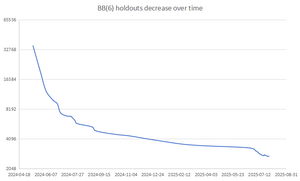BB(6): Difference between revisions
→Techniques: added mitmwfar code summary |
mNo edit summary |
||
| Line 20: | Line 20: | ||
python3 Code/Enumerate.py --infile "bb6in/bb6tm{i}.txt" --outfile "bb6out/t{i}.pb" -r --no-steps --exp-linear-rules --max-loops=50_000_000 --block-mult=3 --max-block-size=100 --time=500 --force --save-freq=1 | python3 Code/Enumerate.py --infile "bb6in/bb6tm{i}.txt" --outfile "bb6out/t{i}.pb" -r --no-steps --exp-linear-rules --max-loops=50_000_000 --block-mult=3 --max-block-size=100 --time=500 --force --save-freq=1 | ||
</syntaxhighlight>For context, during the Stage 2 BB(7) enumeration, where speed was more important due to the tens of millions of known holdouts, parameters of <code>--max-loops=100_000 --block-mult=2 --time=30 --save-freq=100</code> were used. @Xnoob ran Enumerate.py on all TMs in the 2728 holdout list with the above max-loops and max-block-size parameters using <code>--block-mult=1</code> ,<code>--block-mult=2</code> , and <code>--block-mult=3</code>. | </syntaxhighlight>For context, during the Stage 2 BB(7) enumeration, where speed was more important due to the tens of millions of known holdouts, parameters of <code>--max-loops=100_000 --block-mult=2 --time=30 --save-freq=100</code> were used. @Xnoob ran Enumerate.py on all TMs in the 2728 holdout list with the above max-loops and max-block-size parameters using <code>--block-mult=1</code> ,<code>--block-mult=2</code> , and <code>--block-mult=3</code>. | ||
Andrew Ducharme started running MITMWFAR code on the 2728 holdout list with the command line entry<syntaxhighlight> | Andrew Ducharme started running MITMWFAR code on the 2728 holdout list with the command line entry<syntaxhighlight> | ||
Revision as of 02:39, 4 August 2025
The 6-state, 2-symbol Busy Beaver problem, BB(6), refers to the unsolved 6th value of the Busy Beaver function. With the discovery of the Cryptid machine Antihydra in June 2024, we now know that we must solve a Collatz-like problem in order to solve BB(6) and thus BB(6) is Hard.
The current BB(6) champion 1RB1RA_1RC1RZ_1LD0RF_1RA0LE_0LD1RC_1RA0RE (bbch) was discovered by mxdys in June 2025, proving the lower bound:
Techniques
Simulating tetrational machines, such as the former champion 1RB0LD_1RC0RF_1LC1LA_0LE1RZ_1LF0RB_0RC0RE (bbch), requires accelerated simulation that can handle Collatz Level 2 inductive rules. In other words, it requires a simulator that can prove the rules:
and also compute the remainder mod 3 of numbers produced by applying these rules 15 times (which requires some fancy math related to Euler's totient function).
We are also applying existing automatic deciders, such as the Ligockis' Enumerate.py and @Iijil's MITMWFAR, on current holdout lists with more extreme choices of parameters (more computational resources). @XnoobSpeakable was able to solve 12 of the final 2728 holdouts using higher order parameters with Enumerate.py. An example command line entry is:
python3 Code/Enumerate.py --infile "bb6in/bb6tm{i}.txt" --outfile "bb6out/t{i}.pb" -r --no-steps --exp-linear-rules --max-loops=50_000_000 --block-mult=3 --max-block-size=100 --time=500 --force --save-freq=1For context, during the Stage 2 BB(7) enumeration, where speed was more important due to the tens of millions of known holdouts, parameters of --max-loops=100_000 --block-mult=2 --time=30 --save-freq=100 were used. @Xnoob ran Enumerate.py on all TMs in the 2728 holdout list with the above max-loops and max-block-size parameters using --block-mult=1 ,--block-mult=2 , and --block-mult=3.
Andrew Ducharme started running MITMWFAR code on the 2728 holdout list with the command line entry
./MITMWFAR -n=N -m=M -pm=1 < ./solvable_BB6_holdouts.txt > solved_nN_mM.txtThe flags -n and -m set the number of maximum non-dead transitions scanned and the size of each weighted finite automaton's memory, respectively. Increasing n increases computation time much faster than increasing m does. The following table lists the tested combinations of parameters tried already and their (so far, disappointing) results. Blank entries mean the computation has not been attempted yet.
| n = 9 | n = 10 | n = 11 | n = 12 | n = 13 | |
|---|---|---|---|---|---|
| m = 1 | 0 | 0 | 0 | 0 | |
| m = 2 | 0 |
Cryptids
Several Turing machines have been found that are Cryptids, considered so because each of them have a Collatz-like halting problem, a type of problem that is generally difficult to solve. However, probabilistic arguments have allowed all but one of them to be categorized as probviously halting or probviously non-halting.
Probviously non-halting Cryptids:
1RB1RA_0LC1LE_1LD1LC_1LA0LB_1LF1RE_---0RA(bbch), Antihydra1RB1RC_1LC1LE_1RA1RD_0RF0RE_1LA0LB_---1RA(bbch), a variant of Hydra and Antihydra1RB1LD_1RC1RE_0LA1LB_0LD1LC_1RF0RA_---0RC(bbch), similar to Antihydra1RB0LD_1RC1RF_1LA0RA_0LA0LE_1LD1LA_0RB---(bbch), similar to Antihydra1RB0LB_1LC0RE_1LA1LD_0LC---_0RB0RF_1RE1RB(bbch), similar to Antihydra1RB1LA_1LC0RE_1LF1LD_0RB0LA_1RC1RE_---0LD(bbch)
Probviously halting Cryptids:
1RB0RD_0RC1RE_1RD0LA_1LE1LC_1RF0LD_---0RA(bbch), Lucy's Moonlight1RB1RA_0RC1RC_1LD0LF_0LE1LE_1RA0LB_---0LC(bbch), a family of 16 related TMs1RB1RE_1LC1LD_---1LA_1LB1LE_0RF0RA_1LD1RF(bbch)1RB0RE_1LC1LD_0RA0LD_1LB0LA_1RF1RA_---1LB(bbch)1RB0LC_0LC0RF_1RD1LC_0RA1LE_---0LD_1LF1LA(bbch)1RB0LC_1LC0RD_1LF1LA_1LB1RE_1RB1LE_---0LE(bbch)1RB---_0RC0RE_1RD1RF_1LE0LB_1RC0LD_1RC1RA(bbch)1RB0LD_1RC1RA_1LD0RB_1LE1LA_1RF0RC_---1RE(bbch)
Although 1RB1LE_0LC0LB_1RD1LC_1RD1RA_1RF0LA_---1RE (bbch) behaves similarly to the probviously halting Cryptids, it is estimated to have a 3/5 chance of becoming a translated cycler and a 2/5 chance of halting.
There are a few machines considered notable for their chaotic behaviour, but which have not been classified as Cryptids due to seemingly lacking a connection to any known open mathematical problems, such as Collatz-like problems.
Potential Cryptids:
1RB1RE_1LC0RA_0RD1LB_---1RC_1LF1RE_0LB0LE(bbch)1RB0LD_1LC0RA_1RA1LB_1LA1LE_1RF0LC_---0RE(bbch)1RB0RB_1LC1RE_1LF0LD_1RA1LD_1RC1RB_---1LC(bbch)
Top Halters
Below is a table of the machines with the 10 highest known runtimes.[1] Their sigma scores are expressed using an extension of Knuth's up-arrow notation.[2]
| Standard format | (approximate) Σ |
|---|---|
1RB1RA_1RC1RZ_1LD0RF_1RA0LE_0LD1RC_1RA0RE (bbch)
|
2 ↑↑↑ 5 |
1RB1LC_1LA1RE_0RD0LA_1RZ1LB_1LD0RF_0RD1RB (bbch)
|
10 ↑↑ 11010000 |
1RB0LD_1RC0RF_1LC1LA_0LE1RZ_1LF0RB_0RC0RE (bbch)
|
10 ↑↑ 15.60465 |
1RB0LF_1RC1RB_1LD0RA_1LB0LE_1RZ0LC_1LA1LF (bbch)
|
10 ↑↑ 7.52390 |
1RB0LF_1RC1RB_1LD0RA_1RF0LE_1RZ0LC_1LA1LF (bbch)
|
10 ↑↑ 7.52390 |
1RB0LF_1RC1RB_1LD0RA_1LF0LE_1RZ0LC_1LA1LF (bbch)
|
10 ↑↑ 7.52390 |
1RB1RC_1LC1RE_1LD0LB_1RE1LC_1LE0RF_1RZ1RA (bbch)
|
10 ↑↑ 7.23619 |
1RB1RA_1LC1LE_1RE0LD_1LC0LF_1RZ0RA_0RA0LB (bbch)
|
10 ↑↑ 6.96745 |
1RB0RF_1LC0RA_1RZ0LD_1LE1LD_1RB1RC_0LD0RE (bbch)
|
10 ↑↑ 5.77573 |
1RB0LA_1LC1LF_0LD0LC_0LE0LB_1RE0RA_1RZ1LD (bbch)
|
10 ↑↑ 5.63534 |
The runtimes are presumed to be about which is roughly indistinguishable in tetration notation.
Holdouts

@mxdys's informal holdouts list has 2728 machines up to equivalence as of July 2025.
References
- ↑ Shawn Ligocki's list of 6-state, 2-symbol machines with large runtimes (Link)
- ↑ Shawn Ligocki. 2022. "Extending Up-arrow Notation"